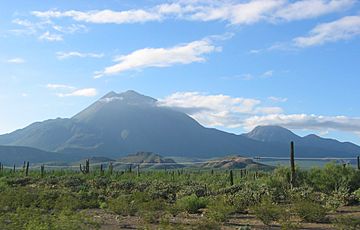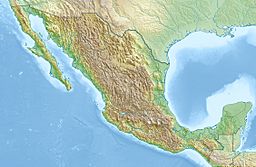Tres Vírgenes facts for kids
Quick facts for kids Volcán Las Tres Vírgenes |
|
|---|---|
| El Virgen | |

Volcán Las Tres Vírgenes in 2004.
|
|
| Highest point | |
| Elevation | 1,940 m (6,360 ft) |
| Prominence | 1,610 m (5,280 ft) |
| Listing |
|
| Geography | |
| Location | Baja California Sur, Mexico |
| Geology | |
| Mountain type | Stratovolcano |
| Last eruption | Disputed, see Eruption history section |
Tres Vírgenes is a group of three volcanoes in Baja California Sur, a state in northwestern Mexico. These volcanoes are part of a long chain that stretches from Baja California into the Guaymas Basin.
The complex has three main volcanoes lined up from northeast to southwest. The oldest is El Viejo, then El Azufre in the middle, and the youngest is El Vírgen. Even though there are three, the whole group is often called "Las Tres Vírgenes" because El Vírgen is the most noticeable one.
Contents
What is Volcán Las Tres Vírgenes?
Volcán Las Tres Vírgenes is a group of volcanoes that includes El Azufre and El Viejo. This volcanic area is found within the Gulf of California rift zone. This means it's in a place where the Earth's crust is pulling apart. It's part of a volcanic chain that goes from the eastern coast of Baja California towards active areas in the Guaymas Basin where new seafloor is forming.
How the Volcanoes Formed
The oldest rocks under Las Tres Vírgenes are granite, formed during the Cretaceous period. On top of these old rocks are layers of younger volcanic material. This includes rocks like andesite and basalt.
Below these volcanic layers is the Santa Rosalia Formation. This layer has marine deposits, meaning it was formed under shallow water. It contains fossils, which help scientists identify it.
The very top layers of the volcano are made of different kinds of pyroclastic particles. These are bits of rock, ash, and lava that were blasted out during eruptions. The rocks from Las Tres Vírgenes are similar to those from calc-alkaline magma. This type of magma is common in volcanoes found where one tectonic plate slides under another.
The Three Volcanoes' History
The three volcanoes started forming at different times:
- El Viejo: This is the oldest volcano in the group. It began forming about 300,000 years ago. It started with dacitic lava flows and domes.
- El Azufre: Volcanic activity then moved southwest, forming El Azufre about 173,000 years ago.
- El Vírgen: The youngest volcano, El Vírgen, started forming around 112,000 years ago. It also formed southwest of El Azufre.
El Vírgen was once the largest of the three, with a cone volume of about 31.2 cubic kilometers. El Viejo was next at 4.2 cubic kilometers, and El Azufre was the smallest at 3.8 cubic kilometers.
El Viejo: The Oldest Volcano
El Viejo is the oldest of the Tres Vírgenes volcanoes. It is made up of three main lava domes. These domes formed from thick, slow-moving lava.
- Lower Viejo Dacite: This is the oldest dome. It has light gray lava with dark gray spots.
- Puerta Dacite: This dome is on top of the Lower Viejo dacite. It has a blocky surface and contains rounded rock pieces.
- Upper Viejo Dacite: This is the youngest dome of El Viejo. It also has a blocky surface and contains rounded rock pieces.
El Azufre: The Middle Volcano
El Azufre volcano has block and ash flows. These are fast-moving currents of hot gas and volcanic debris. They spread out like fans from the volcano. The volcano also has a dacite central dome on its top. This dome is about 0.3 kilometers high. The lava here can be dark gray or pinkish-gray. It also contains dark gray rock pieces.
El Vírgen: The Youngest and Most Complex
El Vírgen is the most visible and complex of the three volcanoes. It has at least six scoria cones spread around it. Scoria cones are small, steep-sided volcanoes built from bits of frothy lava.
- Three of these cones are on the southern side of El Azufre. They are long and joined together.
- El Vírgen also has six types of andesite lava flows.
- There is one "neck" which is like a feeding pipe for the volcano. It is mostly covered by newer volcanic material.
- The main structure of El Vírgen is a dacite lava cone.
- There are also four lava domes on El Vírgen. Two of these, called Mezquital dacite lava domes, are on the southern side of the volcano.
As you can see, El Vírgen has many different parts, including lavas, cones, and domes, making it the most complicated of the three.
Eruption History
The last time any of the Tres Vírgenes volcanoes erupted was El Vírgen. However, the exact date of this eruption is not certain.
- A map made by a Croatian missionary in 1746 mentions an eruption.
- But, scientific dating methods don't agree with this date.
- A piece of charcoal found in volcanic rock was dated to about 6,515 years ago.
- A lava flow, which must be younger than the eruption itself, was dated to about 24,000 years ago.
- Fragments of ash (called tephra) from El Vírgen were dated to about 36,000 years ago.
These different dates show that scientists are still working to figure out the exact time of El Vírgen's last eruption.
See also
- Volcanoes of east-central Baja California
- List of volcanoes in Mexico
- List of Ultras of Mexico
- List of mountain peaks of Mexico
 In Spanish: Las Tres Vírgenes para niños
In Spanish: Las Tres Vírgenes para niños


